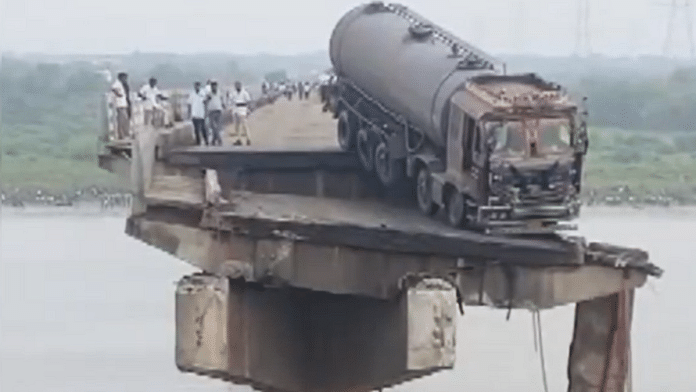New Delhi: Thirty-five-year-old Sonal Padhiyar set out from Vadodara early Thursday morning with her husband and two young children to visit a temple in Bagdana, Bhavnagar. Just a few kilometres into the 280 km journey, the trip came to a horrific end. The Gambhira bridge collapsed, and their van plunged into the Mahisagar river, killing her four-year-old daughter and one-year-old son.
“I was screaming for help. There were seven passengers in our van. We left at 6.30 am and reached the bridge around 7. When we were crossing, a portion collapsed, causing many vehicles to fall into the river,” said Padhiyar.
At least 12 people have died in the collapse of the Gambhira bridge, which connects central Gujarat to the Saurashtra region. Now, reports suggest that local residents had raised concerns about the safety of the bridge years ago, but no action was taken.
The Gambhira bridge is only the latest in a series of such incidents. India’s bridges have been collapsing for years, pointing to a larger problem plaguing our infrastructure projects. Lack of safety measures and widespread corruption in public works contracts, especially in local civic projects, is rampant. This neglect is costing innocent lives. India can’t call itself a future economic superpower without getting its basic civic infrastructure right. And that is why the recent bridge collapses are ThePrint Newsmaker of the Week.
In June this year, a 30-year-old bridge collapsed in Pune, killing four people. In Bihar last year, 10 bridges collapsed within just over two weeks. Several of these bridges fell before they were even inaugurated, raising serious questions about the quality of materials used and the role of contractors. Many have alleged that tenders are won through bribes.
On 9 July, as the Gambhira bridge gave way, a van, a tanker, an autorickshaw, and multiple two-wheelers were swept into the river. Among the dead were two children, their father, a man on his way to work, and an entire family headed to the temple. Sonalben Padhiyar was the only survivor.
The Gujarat government has declared it a tragedy and initiated the investigation, but this too is part of the same cycle: warnings get ignored, tragedy strikes, an inquiry is ordered, sometimes compensation is announced. Then there’s silence—until the next collapse.
The Gambhira bridge was built in 1985. Letters of warning about cracks and corroded slabs had been sent to the Roads & Buildings Department as early as 2021. In 2022, the bridge had reportedly been deemed unfit for use, but not even a warning was sent out to the residents.
Every day, people crossed the bridge, unaware of the danger that lay beneath their feet
In Gujarat’s Morbi bridge collapse, around 135 people had lost their lives. That was nearly three years ago. And yet, here we are again.
Also Read: 4 dead, 32 injured in bridge collapse over Indrayani River near Pune, 10-15 people feared swept away
Safety and infrastructure
The Modi government has been heavily promoting its ‘Viksit Bharat’ vision. From expressways to metros, from Setu Bharatam to PM Gati Shakti, India has seen a massive infrastructure push. Mega projects like the Chenab bridge and marquee freight corridors are underway, but the foundation beneath it all is crumbling.
A survey by the Ministry of Road Transport and Highways in 2017 reported that over 6,500 bridges on national highways were in a ‘distressed’ condition, with 20 bridges over a century old being decommissioned as an urgent priority.
“Visual as well as equipment-based periodical inspection, evaluation and monitoring has been mandated for NHs, including bridges, to ensure that structural integrity of various components…is maintained through timely repair/rehabilitation intervention,” the ministry said in a Lok Sabha reply last November.
But the care and maintenance for such infrastructure still faces neglect. At the local level, it’s either a paucity of funds or a lack of urgency. Accountability in the tendering process is weak, and private contractors have created a dangerous ecosystem of cutting costs for more profits.
In many cases, contracts are not given on the merit of the contractor but on the basis of political connections or under-the-table payments. Many evade the burden of following safety protocols and facing audits by paying bribes.
Safety certificates are manipulated, mandatory site inspections and load tests are also often rigged.
India is building time bombs and the system appears to be designed to reward speed and cost-cutting, not safety.
Views are personal.
(Edited by Asavari Singh)






